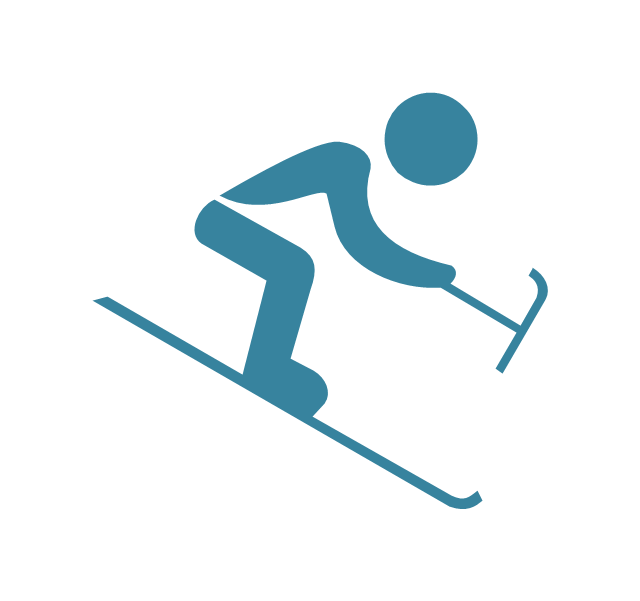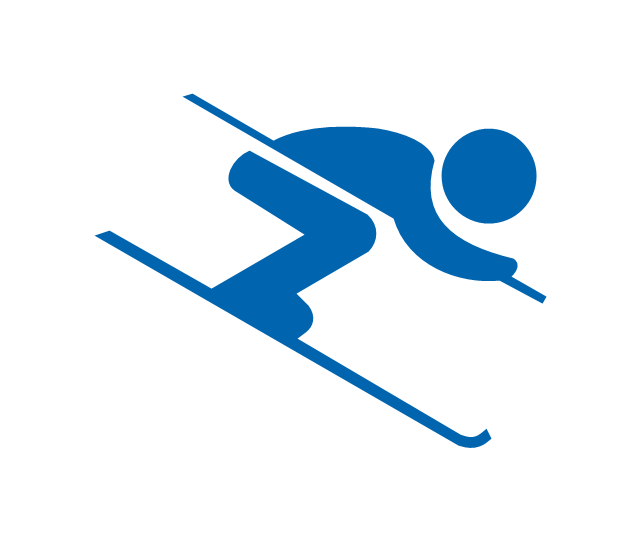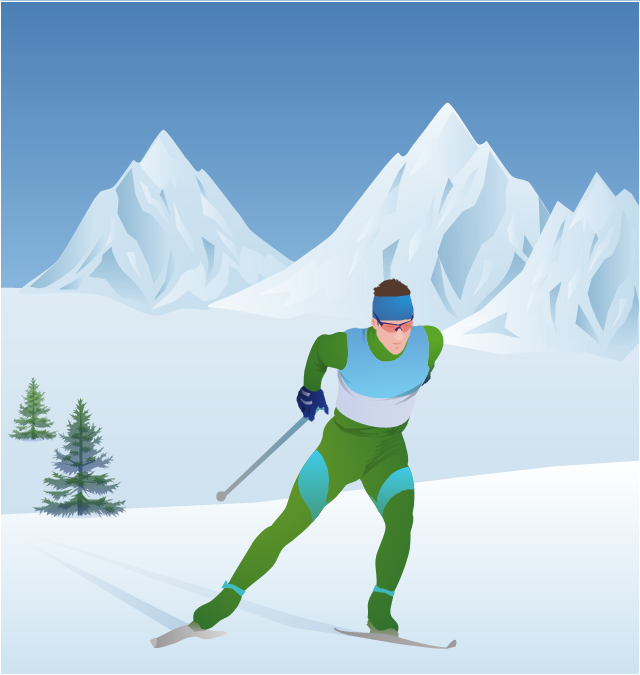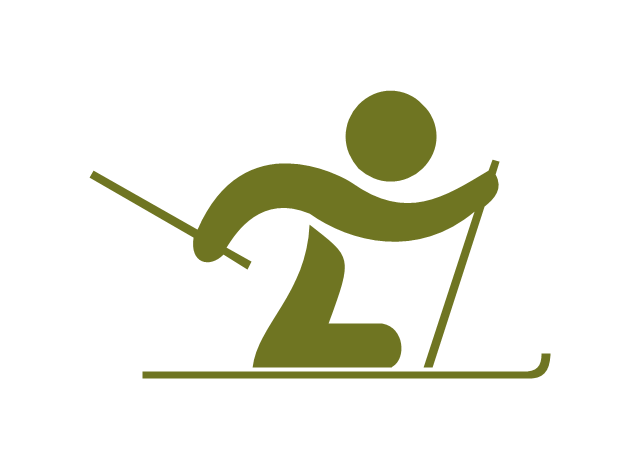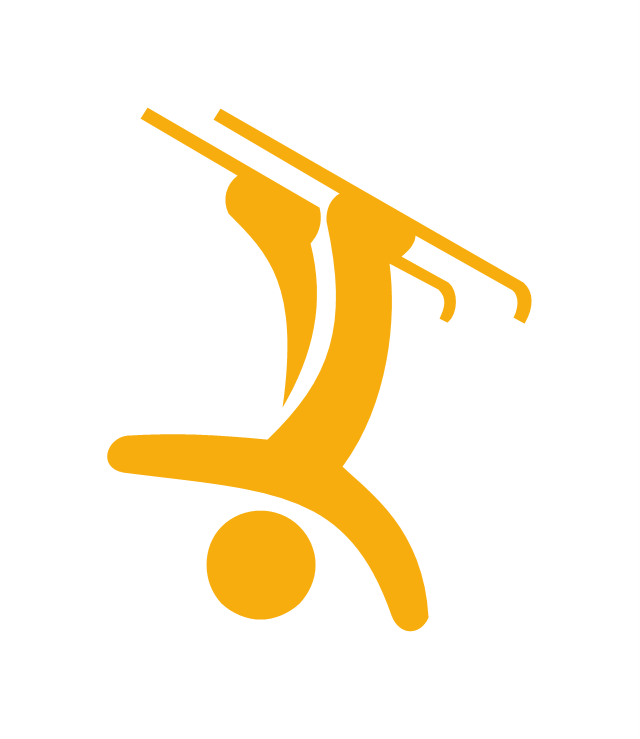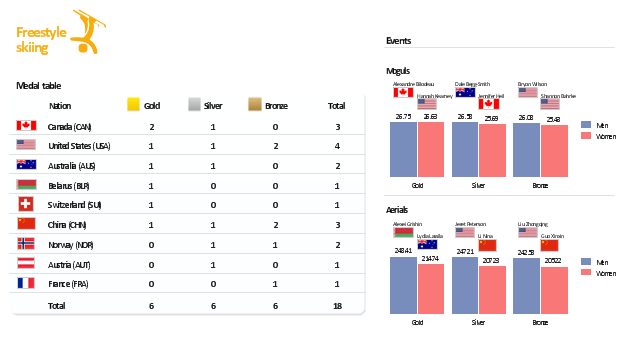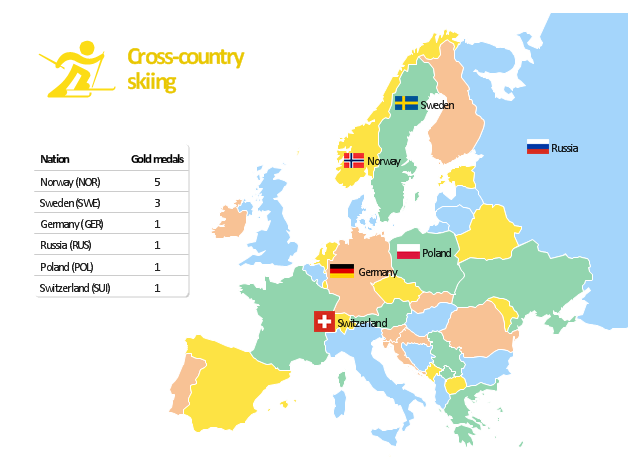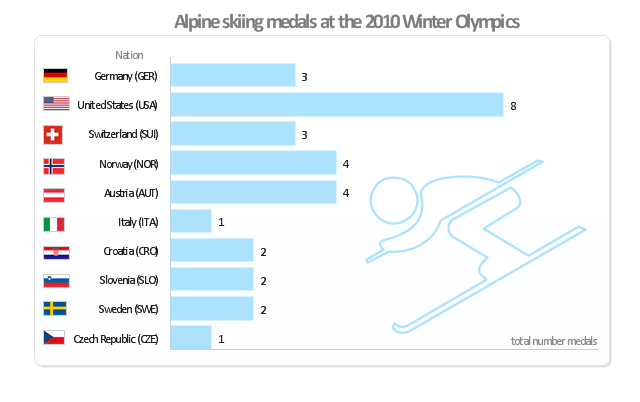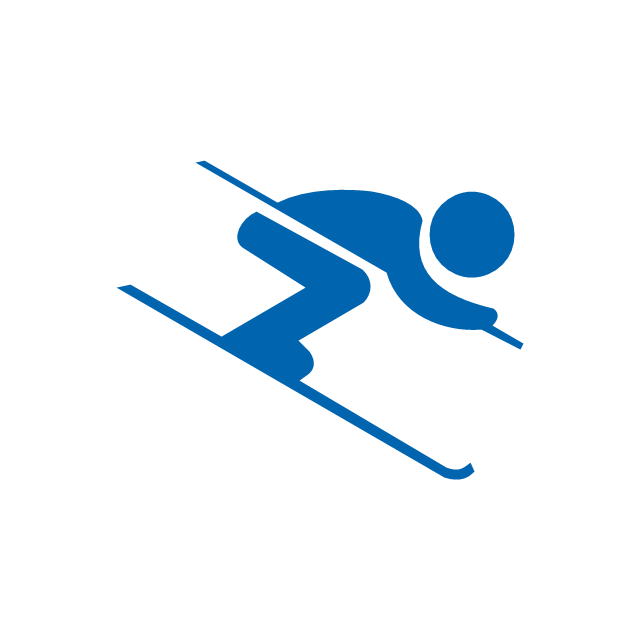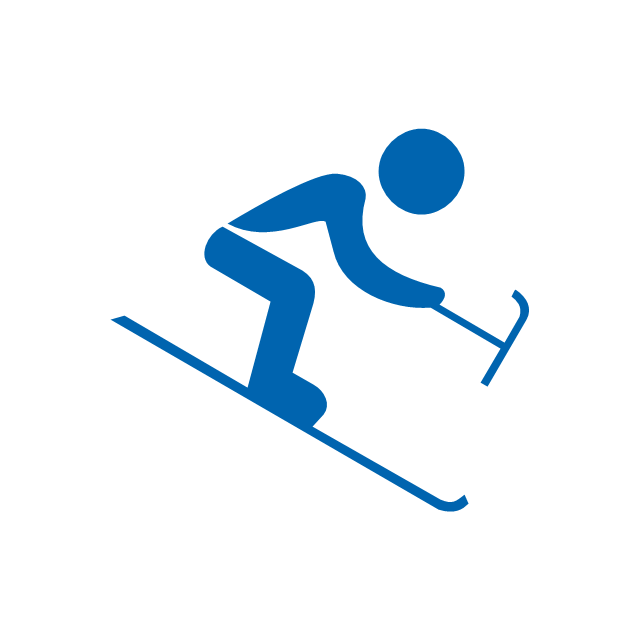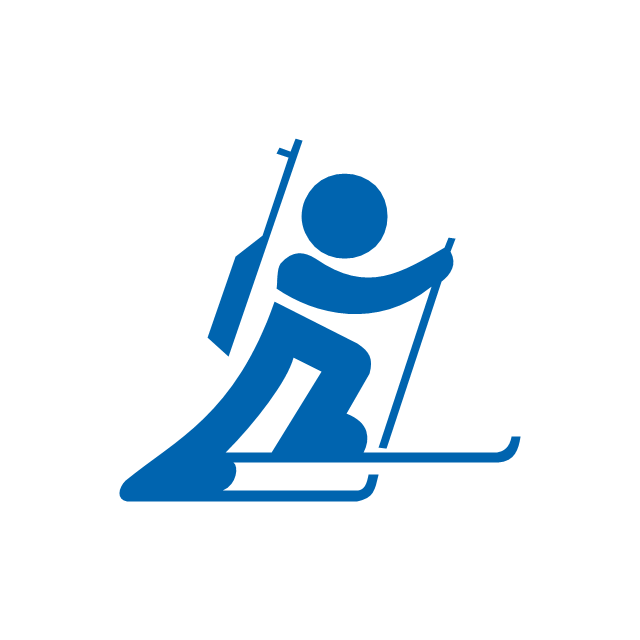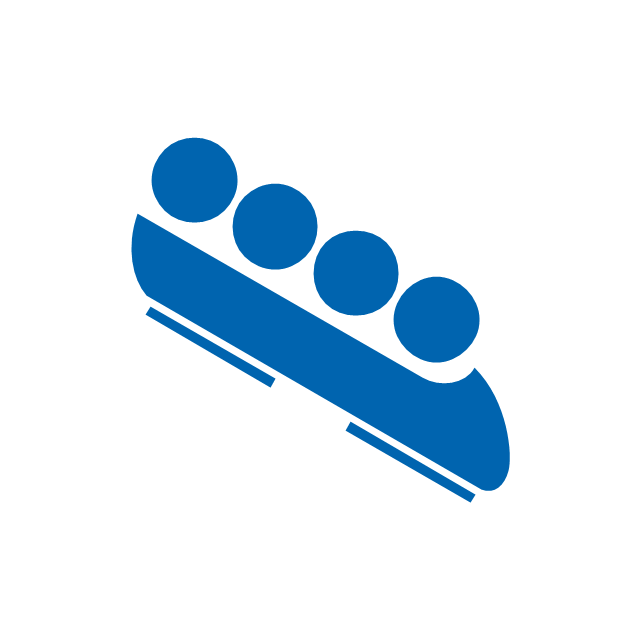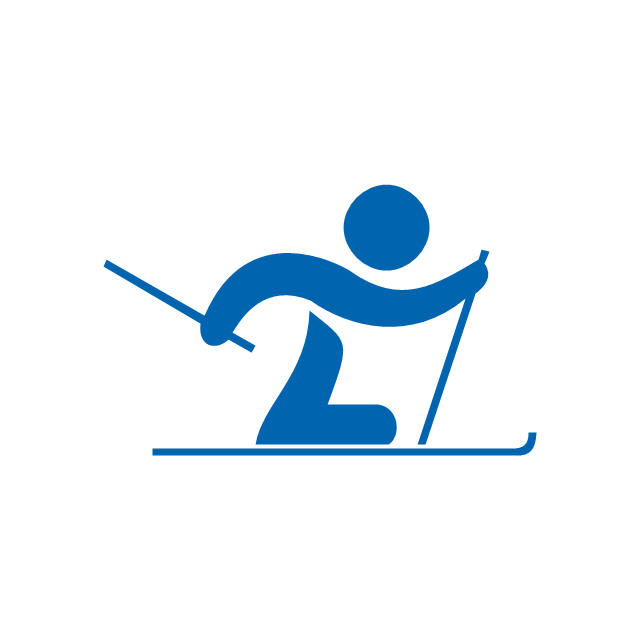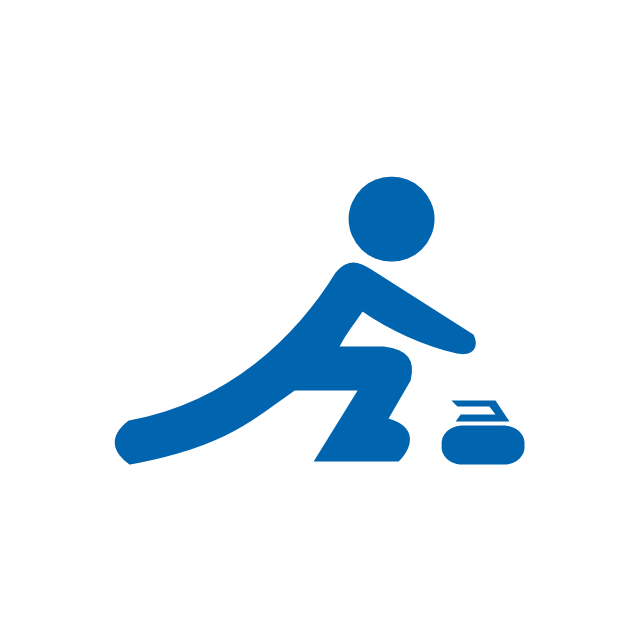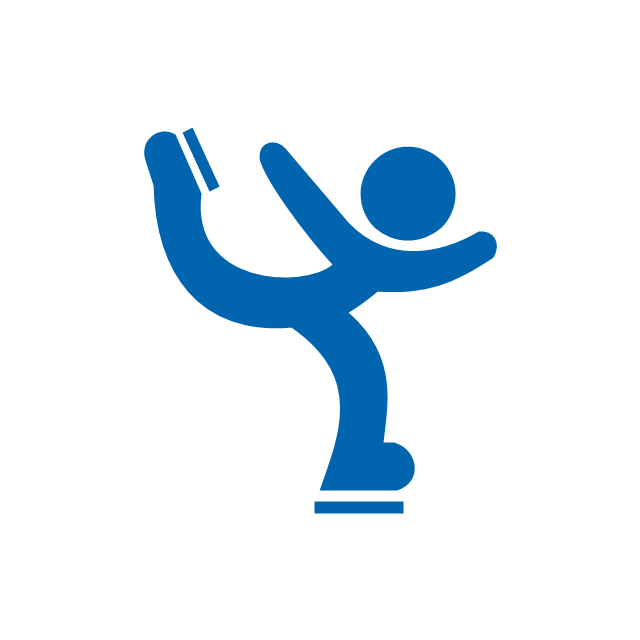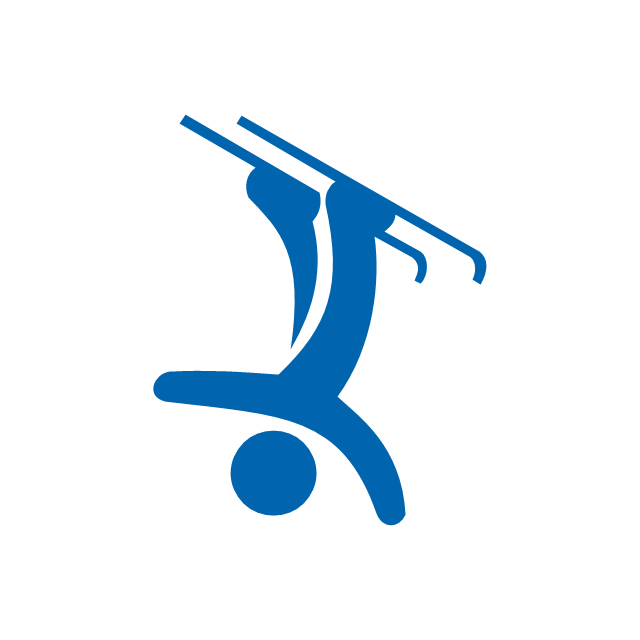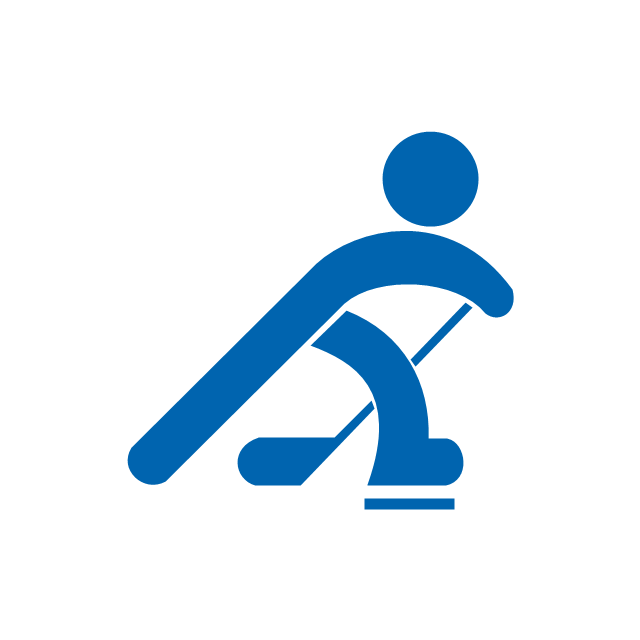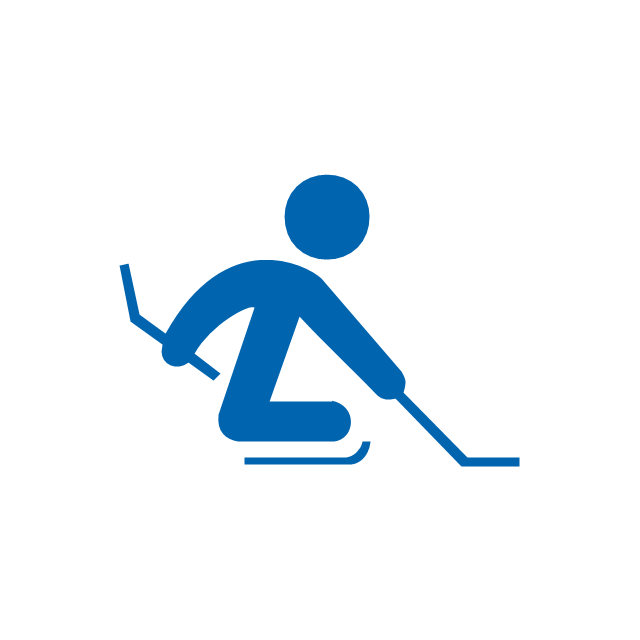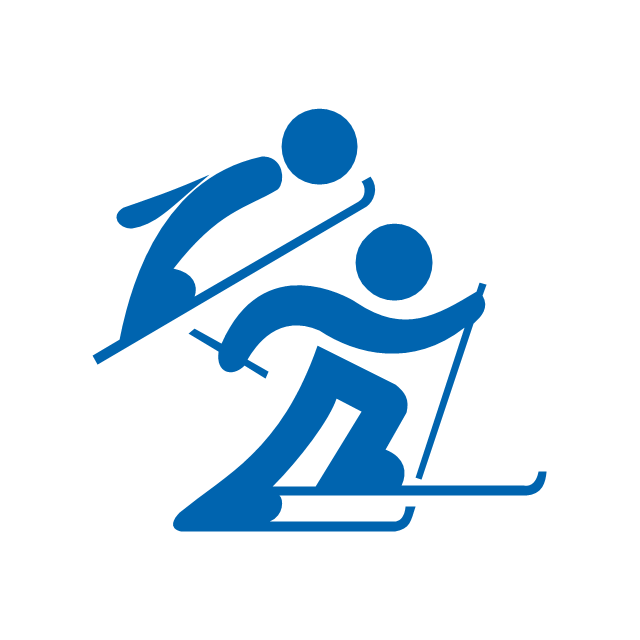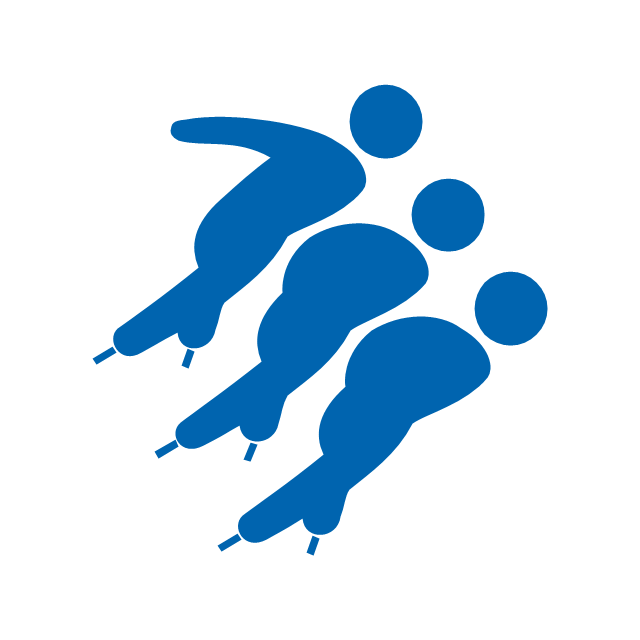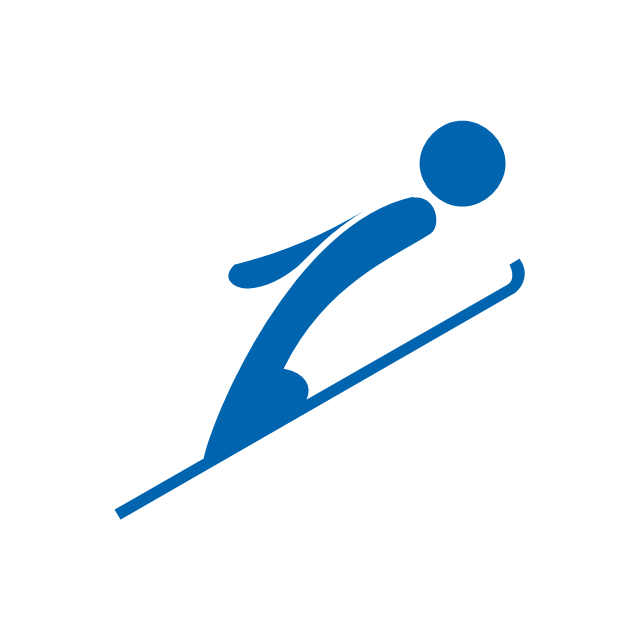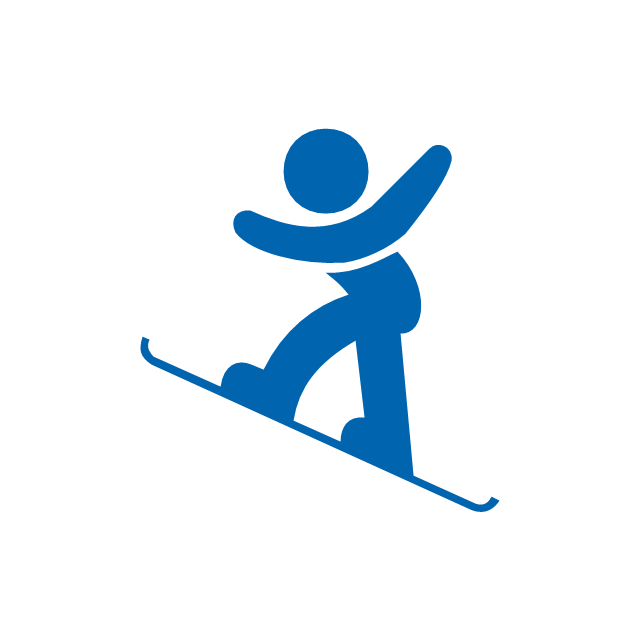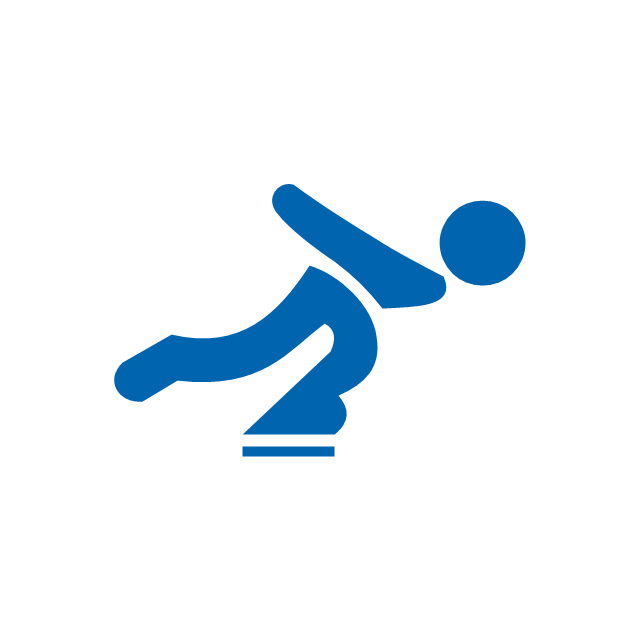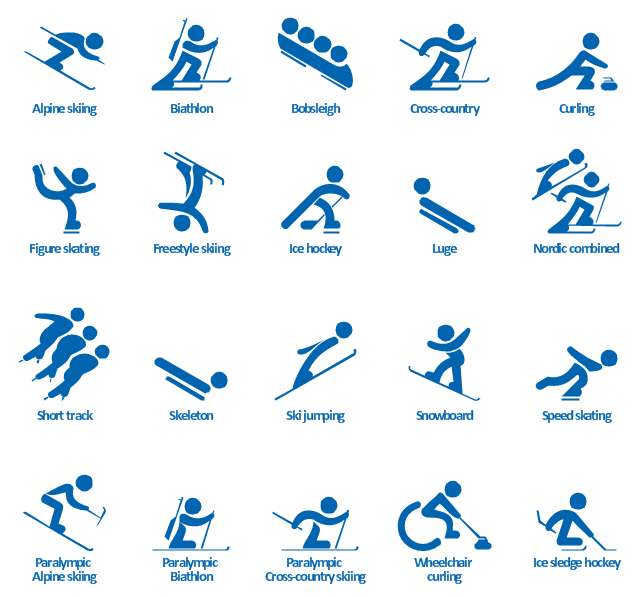"Paralympic alpine skiing is an adaptation of alpine skiing for athletes with a disability. The sport evolved from the efforts of disabled veterans in Germany and Austria during and after the Second World War. The sport is governed by the International Paralympic Committee Sports Committee. The primary equipment used includes outrigger skis, sit-skis, and mono-skis. Para-alpine skiing disciplines include the Downhill, Super-G, Giant Slalom, Slalom, Super Combined and Snowboard.
Para-alpine skiing classification is the classification system for para-alpine skiing designed to insure fair competition between alpine skiers with different types of disabilities. The classifications are grouped into three general disability types: standing, blind and sitting. A factoring system was created for para-alpine skiing to allow the three classification groupings to fairly compete against each other in the same race despite different functional skiing levels and medical issues.
Alpine skiing was one of the foundation sports at the first Winter Paralympics in 1976 with Slalom and Giant Slalom events being held. Different disciplines were added to the Paralympic programme over time. The 2010 Winter Paralympics para-alpine skiing events were held at Whistler Creekside. The disciplines at Whistler included Downhill, Super-Combined, Super-G, Slalom and Giant Slalom." [Para-alpine skiing. Wikipedia]
The vector icon example "Alpine skiing, paralympic" represents one of 20 symbols from the Winter sports pictograms library for the ConceptDraw PRO diagramming and vector drawing software.
The design elements library Winter sports pictograms is included in the Winter Sports solution from the Sport area of ConceptDraw Solution Park.
Para-alpine skiing classification is the classification system for para-alpine skiing designed to insure fair competition between alpine skiers with different types of disabilities. The classifications are grouped into three general disability types: standing, blind and sitting. A factoring system was created for para-alpine skiing to allow the three classification groupings to fairly compete against each other in the same race despite different functional skiing levels and medical issues.
Alpine skiing was one of the foundation sports at the first Winter Paralympics in 1976 with Slalom and Giant Slalom events being held. Different disciplines were added to the Paralympic programme over time. The 2010 Winter Paralympics para-alpine skiing events were held at Whistler Creekside. The disciplines at Whistler included Downhill, Super-Combined, Super-G, Slalom and Giant Slalom." [Para-alpine skiing. Wikipedia]
The vector icon example "Alpine skiing, paralympic" represents one of 20 symbols from the Winter sports pictograms library for the ConceptDraw PRO diagramming and vector drawing software.
The design elements library Winter sports pictograms is included in the Winter Sports solution from the Sport area of ConceptDraw Solution Park.
"Alpine skiing is the sport of sliding down snow-covered hills on skis with fixed-heel bindings. It is also commonly known as downhill skiing, although that also incorporates different styles. Alpine skiing can be contrasted with skiing using free-heel bindings; ski mountaineering and nordic skiing – such as cross-country; ski jumping; and Telemark. Alpine skiing is popular wherever the combination of snow, mountain slopes, and a sufficient tourist infrastructure can be built up, including parts of Europe, North America, Australia and New Zealand, the South American Andes, and East Asia.
Alpine skiing began as a club sport 1861 at Kiandra in Australia and a number of similar clubs in North America and the Austrian and Swiss Alps. Today, most alpine skiing occurs at a ski resort with ski lifts that transport skiers up the mountain. The snow is groomed, avalanches are controlled and trees are cut to create trails. Many resorts also include snow making equipment to provide skiing when the weather would otherwise not allow it. Alternatively, alpine skiers may pursue the sport in less controlled environments; this practice is variously referred to as ski touring, backcountry skiing, or extreme skiing.
In competitive alpine skiing races four disciplines exist: slalom, giant slalom, super giant slalom, and downhill. Slalom ski races have courses that require short tight turns, whereas giant-slalom races have courses which are set with more widely spaced turns. Super-giant slalom and downhill have few turns, the courses have gates spaced widely apart and skiers often reach 100 km/ h." [Alpine skiing. Wikipedia]
The vector icon example "Alpine skiing" represents one of 20 symbols from the Winter sports pictograms library for the ConceptDraw PRO diagramming and vector drawing software.
The design elements library Winter sports pictograms is included in the Winter Sports solution from the Sport area of ConceptDraw Solution Park.
Alpine skiing began as a club sport 1861 at Kiandra in Australia and a number of similar clubs in North America and the Austrian and Swiss Alps. Today, most alpine skiing occurs at a ski resort with ski lifts that transport skiers up the mountain. The snow is groomed, avalanches are controlled and trees are cut to create trails. Many resorts also include snow making equipment to provide skiing when the weather would otherwise not allow it. Alternatively, alpine skiers may pursue the sport in less controlled environments; this practice is variously referred to as ski touring, backcountry skiing, or extreme skiing.
In competitive alpine skiing races four disciplines exist: slalom, giant slalom, super giant slalom, and downhill. Slalom ski races have courses that require short tight turns, whereas giant-slalom races have courses which are set with more widely spaced turns. Super-giant slalom and downhill have few turns, the courses have gates spaced widely apart and skiers often reach 100 km/ h." [Alpine skiing. Wikipedia]
The vector icon example "Alpine skiing" represents one of 20 symbols from the Winter sports pictograms library for the ConceptDraw PRO diagramming and vector drawing software.
The design elements library Winter sports pictograms is included in the Winter Sports solution from the Sport area of ConceptDraw Solution Park.
"Cross-country skiing (or XC skiing) is a form of ski touring in which participants propel themselves across snow-covered terrain using skis and poles. The activity is popular in many places with large snowfields, primarily Northern Europe, Canada, and Alaska.
Cross-country skiing is part of the Nordic skiing sport family, which includes ski jumping, Nordic combined (cross-country skiing and ski jumping), Biathlon (skiing and rifle marksmanship) and ski-orienteering (which includes map navigation along snow trails and tracks). Cross-country skiing is the modern style of skiing that most resembles prehistoric skiing, particularly when done in the backcountry. It is also related to Telemark skiing." [Cross-country skiing. Wikipedia]
The vector icon example "Cross-country skiing" represents one of 20 symbols from the Winter sports pictograms library for the ConceptDraw PRO diagramming and vector drawing software.
The design elements library Winter sports pictograms is included in the Winter Sports solution from the Sport area of ConceptDraw Solution Park.
Cross-country skiing is part of the Nordic skiing sport family, which includes ski jumping, Nordic combined (cross-country skiing and ski jumping), Biathlon (skiing and rifle marksmanship) and ski-orienteering (which includes map navigation along snow trails and tracks). Cross-country skiing is the modern style of skiing that most resembles prehistoric skiing, particularly when done in the backcountry. It is also related to Telemark skiing." [Cross-country skiing. Wikipedia]
The vector icon example "Cross-country skiing" represents one of 20 symbols from the Winter sports pictograms library for the ConceptDraw PRO diagramming and vector drawing software.
The design elements library Winter sports pictograms is included in the Winter Sports solution from the Sport area of ConceptDraw Solution Park.
"Cross-country skiing at the 2014 Winter Olympics will be held at the Laura Biathlon & Ski Complex near Krasnaya Polyana, Russia. The ten events are scheduled for February 8–23, 2014.
Women's skiathlon;
Men's skiathlon;
Individual sprint free men/ women;
Women's 10 km classical;
Men's 15 km classical;
4 x 5 km relay women;
4 x 10 km relay men;
Team sprint classical men/ women;
Women's 30 km mass start free;
Men's 50 km mass start free.
A total of 310 quota spots are available to athletes to compete at the games. A maximum of 20 athletes can be entered by a National Olympic Committee, with a maximum of 12 men or 12 women. There are two qualification standards for the games: an A standard and a B standard." [Cross-country skiing at the 2014 Winter Olympics. Wikipedia]
The vector illustration "Winter Olympics - Cross-country skiing" was created using the ConceptDraw PRO diagramming and vector drawing software extended with the Winter Sports solution. The Winter Sports solution from the Sport area of ConceptDraw Solution Park contains the Sochi 2014 Winter Olimpics sports vector pictograms and clipart libraries and examples of diagrams, illustrations and infographics.
Women's skiathlon;
Men's skiathlon;
Individual sprint free men/ women;
Women's 10 km classical;
Men's 15 km classical;
4 x 5 km relay women;
4 x 10 km relay men;
Team sprint classical men/ women;
Women's 30 km mass start free;
Men's 50 km mass start free.
A total of 310 quota spots are available to athletes to compete at the games. A maximum of 20 athletes can be entered by a National Olympic Committee, with a maximum of 12 men or 12 women. There are two qualification standards for the games: an A standard and a B standard." [Cross-country skiing at the 2014 Winter Olympics. Wikipedia]
The vector illustration "Winter Olympics - Cross-country skiing" was created using the ConceptDraw PRO diagramming and vector drawing software extended with the Winter Sports solution. The Winter Sports solution from the Sport area of ConceptDraw Solution Park contains the Sochi 2014 Winter Olimpics sports vector pictograms and clipart libraries and examples of diagrams, illustrations and infographics.
"Paralympic cross-county skiing is an adaptation of cross-country skiing for athletes with a disability. Paralympic cross-country skiing is one of two Nordic skiing disciplines in the Winter Paralympic Games. It is governed by the International Paralympic Committee. ...
Paralympic cross-country skiing includes standing events, sitting events (for wheelchair users), and events for visually impaired athletes.
The Paralympics cross-country skiing is made for skiers with disabilities. It is an adaptation of cross-country skiing, only it allows a wide variety of people who have mutations, amputations, blindness, or any other physical disability, to continue their sport. This sport appeared at the 1976 Winter Games in Örnsköldsvik, Sweden, for the first time. Depending on the competitors’ functional disability, an athlete has the option of using a sit-ski. This is a chair with a pair of skis equipped to the bottom of it. Many Sit-skiers use this because they have no use of their legs. This is called paraplegic. To ensure the safety of people with blindness, they follow a guide through the whole race. Standing skiers are skiers with a locomotive disability and who are able to use the same equipment as able-bodied skiers." [Paralympic cross-country skiing. Wikipedia]
The vector icon example "Cross-country skiing, paralympic" represents one of 20 symbols from the Winter sports pictograms library for the ConceptDraw PRO diagramming and vector drawing software.
The design elements library Winter sports pictograms is included in the Winter Sports solution from the Sport area of ConceptDraw Solution Park.
Paralympic cross-country skiing includes standing events, sitting events (for wheelchair users), and events for visually impaired athletes.
The Paralympics cross-country skiing is made for skiers with disabilities. It is an adaptation of cross-country skiing, only it allows a wide variety of people who have mutations, amputations, blindness, or any other physical disability, to continue their sport. This sport appeared at the 1976 Winter Games in Örnsköldsvik, Sweden, for the first time. Depending on the competitors’ functional disability, an athlete has the option of using a sit-ski. This is a chair with a pair of skis equipped to the bottom of it. Many Sit-skiers use this because they have no use of their legs. This is called paraplegic. To ensure the safety of people with blindness, they follow a guide through the whole race. Standing skiers are skiers with a locomotive disability and who are able to use the same equipment as able-bodied skiers." [Paralympic cross-country skiing. Wikipedia]
The vector icon example "Cross-country skiing, paralympic" represents one of 20 symbols from the Winter sports pictograms library for the ConceptDraw PRO diagramming and vector drawing software.
The design elements library Winter sports pictograms is included in the Winter Sports solution from the Sport area of ConceptDraw Solution Park.
"Freestyle skiing is a form of skiing which originally encompassed three disciplines: aerials, moguls, and ski ballet. Today, freestyle skiing consists of aerial, moguls, skicross, boardercross, Ski half-pipe, Snowboard half-pipe and Slopestyle and have become part of the Olympics. ...
The International Ski Federation (FIS) recognized freestyle as a sport in 1979 and brought in new regulations regarding certification of athletes and jump techniques in an effort to curb the dangerous elements of the competitions. The first World Cup series was staged in 1980 and the first World Championships took place in 1986 in Tignes, France. Freestyle skiing was a demonstration event at the 1988 Winter Olympics in Calgary. Mogul skiing was added as an official medal event at the 1992 Winter Olympics in Albertville, and the aerials event was added for the 1994 Winter Olympics in Lillehammer. ...
Currently there are two main branches of freestyle skiing: one encompassing the more traditional events of moguls and aerials, and a newer branch often called new school, comprising events such as halfpipe, big air, slopestyle, and big mountain or free-skiing. Freeskiing shares characteristics with street skateboarding, BMX, and inline skating. New school skiing has grown so much that new ski companies were created, companies that strictly make twin-tip skis — skis that are designed for taking off and landing "fakie", or "switch" (backwards) on jumps and rails." [Freestyle skiing. Wikipedia]
The vector icon example "Freestyle skiing" represents one of 20 symbols from the Winter sports pictograms library for the ConceptDraw PRO diagramming and vector drawing software.
The design elements library Winter sports pictograms is included in the Winter Sports solution from the Sport area of ConceptDraw Solution Park.
The International Ski Federation (FIS) recognized freestyle as a sport in 1979 and brought in new regulations regarding certification of athletes and jump techniques in an effort to curb the dangerous elements of the competitions. The first World Cup series was staged in 1980 and the first World Championships took place in 1986 in Tignes, France. Freestyle skiing was a demonstration event at the 1988 Winter Olympics in Calgary. Mogul skiing was added as an official medal event at the 1992 Winter Olympics in Albertville, and the aerials event was added for the 1994 Winter Olympics in Lillehammer. ...
Currently there are two main branches of freestyle skiing: one encompassing the more traditional events of moguls and aerials, and a newer branch often called new school, comprising events such as halfpipe, big air, slopestyle, and big mountain or free-skiing. Freeskiing shares characteristics with street skateboarding, BMX, and inline skating. New school skiing has grown so much that new ski companies were created, companies that strictly make twin-tip skis — skis that are designed for taking off and landing "fakie", or "switch" (backwards) on jumps and rails." [Freestyle skiing. Wikipedia]
The vector icon example "Freestyle skiing" represents one of 20 symbols from the Winter sports pictograms library for the ConceptDraw PRO diagramming and vector drawing software.
The design elements library Winter sports pictograms is included in the Winter Sports solution from the Sport area of ConceptDraw Solution Park.
"The freestyle skiing competition of the 2010 Winter Olympics was held at Cypress Mountain. The events took place between the 13 and 25 February 2010, and included a new event for these Olympics, ski cross. ...
For the six events, there are a maximum 180 athletes allowed to compete. This includes a maximum of 30 in moguls, 25 in aerials, and 35 in ski cross, applicable for both genders. No nation can have more than 18 skiers with maximum of ten men or ten women per specific nation. For each event, no nation can enter more than four skiers per individual event.
Skiers are qualified if they have placed in the top 30 in an FIS World Cup event of FIS World Championships in the event concerned. A minimum of 100 FIS points in the respective event. Host nation Canada is expected to enter a skier in all events. If no skier meets the qualification standards, they can enter one skier per event.
Quota allocation will be given using the World Ranking List (WRL) for the twelve-month period of World Cup Standings from the 2008-09 and 2009-10 Freestyle World Cup and the FIS Freestyle World Ski Championships 2009. It will be assigned one slot per skier from the top the WRL downwards. When a nation has the maximum four skiers per event, the next eligible nation on the WRL will be given a slot until the maximum total per event in moguls, aerials, and ski cross per gender has been reached." [Freestyle skiing at the 2010 Winter Olympics. Wikipedia]
This medal table example "Medal summary - Freestyle skiing at the 2010 Winter Olympics" is created using the ConceptDraw PRO diagramming and vector drawing software extended with the Winter Sports solution.
The Winter Sports solution from the Sport area of ConceptDraw Solution Park contains the vector stencils library "Winter sports pictograms" and examples of diagrams and infographics.
For the six events, there are a maximum 180 athletes allowed to compete. This includes a maximum of 30 in moguls, 25 in aerials, and 35 in ski cross, applicable for both genders. No nation can have more than 18 skiers with maximum of ten men or ten women per specific nation. For each event, no nation can enter more than four skiers per individual event.
Skiers are qualified if they have placed in the top 30 in an FIS World Cup event of FIS World Championships in the event concerned. A minimum of 100 FIS points in the respective event. Host nation Canada is expected to enter a skier in all events. If no skier meets the qualification standards, they can enter one skier per event.
Quota allocation will be given using the World Ranking List (WRL) for the twelve-month period of World Cup Standings from the 2008-09 and 2009-10 Freestyle World Cup and the FIS Freestyle World Ski Championships 2009. It will be assigned one slot per skier from the top the WRL downwards. When a nation has the maximum four skiers per event, the next eligible nation on the WRL will be given a slot until the maximum total per event in moguls, aerials, and ski cross per gender has been reached." [Freestyle skiing at the 2010 Winter Olympics. Wikipedia]
This medal table example "Medal summary - Freestyle skiing at the 2010 Winter Olympics" is created using the ConceptDraw PRO diagramming and vector drawing software extended with the Winter Sports solution.
The Winter Sports solution from the Sport area of ConceptDraw Solution Park contains the vector stencils library "Winter sports pictograms" and examples of diagrams and infographics.
"The cross-country skiing competition of the 2010 Winter Olympics in Vancouver were held at Whistler Olympic Park. The events were held between 15 and 28 February 2010. ...
Across the twelve cross-country skiing events, a maximum of 310 athletes are allowed to compete. No nation can have more than 20 skiers competing, with an additional limit of 12 men or 12 women per specific nation. For each event, a nation can enter four skiers in individual events and one team in relay races." [Cross-country skiing at the 2010 Winter Olympics. Wikipedia]
The Europe map example "Cross-country skiing gold medals - 2010 Winter Olympics" is created using the ConceptDraw PRO diagramming and vector drawing software extended with the Winter Sports solution.
The Winter Sports solution from the Sport area of ConceptDraw Solution Park contains the vector stencils library "Winter sports pictograms" and examples of diagrams and infographics.
Across the twelve cross-country skiing events, a maximum of 310 athletes are allowed to compete. No nation can have more than 20 skiers competing, with an additional limit of 12 men or 12 women per specific nation. For each event, a nation can enter four skiers in individual events and one team in relay races." [Cross-country skiing at the 2010 Winter Olympics. Wikipedia]
The Europe map example "Cross-country skiing gold medals - 2010 Winter Olympics" is created using the ConceptDraw PRO diagramming and vector drawing software extended with the Winter Sports solution.
The Winter Sports solution from the Sport area of ConceptDraw Solution Park contains the vector stencils library "Winter sports pictograms" and examples of diagrams and infographics.
"Alpine skiing at the 2010 Winter Olympics was held at Whistler Creekside in Whistler, British Columbia, Canada. The ten events were scheduled for 13–27 February, 2010; weather delayed the first event, the men's downhill, two days until Monday, 15 February. ... Notably absent from the medals in these Olympics were the Austrian men, who had won 8 medals in 2006 and 7 in 2002. France and host Canada were shut out from the podium, as were the German men and the Swiss and Italian women. The U.S. had its best Olympics ever with eight alpine medals, only the fourth nation to achieve that total in a single Olympics (Austria, France, Switzerland). Individually, three men and five women won multiple medals; triple medalists were Bode Miller of the U.S. and Aksel Lund Svindal of Norway, who both won a medal of each color. The sole double gold medalist was Maria Riesch of Germany." [Alpine skiing at the 2010 Winter Olympics. wikipedia]
This medal bar chart example "Alpine skiing at the 2010 Winter Olympics" was created using the ConceptDraw PRO diagramming and vector drawing software extended with the Winter Sports solution.
The Winter Sports solution from the Sport area of ConceptDraw Solution Park contains the vector stencils library "Winter sports pictograms" and examples of diagrams and infographics.
This medal bar chart example "Alpine skiing at the 2010 Winter Olympics" was created using the ConceptDraw PRO diagramming and vector drawing software extended with the Winter Sports solution.
The Winter Sports solution from the Sport area of ConceptDraw Solution Park contains the vector stencils library "Winter sports pictograms" and examples of diagrams and infographics.
The vector stencils library "Winter sports pictograms" contains 20 pictograms of winter sports.
Use it to draw sport illustrations and infographics in the ConceptDraw PRO diagramming and vector drawing software extended with the Winter Sports solution from the Sport area of ConceptDraw Solution Park.
Use it to draw sport illustrations and infographics in the ConceptDraw PRO diagramming and vector drawing software extended with the Winter Sports solution from the Sport area of ConceptDraw Solution Park.
The vector stencils library "Winter sports pictograms" contains 20 pictograms of winter sports.
Use it to draw sport illustrations and infographics in the ConceptDraw PRO diagramming and vector drawing software extended with the Winter Sports solution from the Sport area of ConceptDraw Solution Park.
Use it to draw sport illustrations and infographics in the ConceptDraw PRO diagramming and vector drawing software extended with the Winter Sports solution from the Sport area of ConceptDraw Solution Park.
The vector stencils library "Winter sports pictograms" contains 20 symbols of Winter Olympic sports: Alpine skiing, Alpine skiing paralympic, Biathlon, Biathlon paralympic, Bobsleigh, Cross-country, Cross-country skiing paralympic, Curling, Wheelchair curling, Figure skating, Freestyle skiing, Ice hockey, Ice sledge hockey, Luge, Nordic combined, Short track, Skeleton, Ski jumping, Snowboard, Speed skating.
The design elements library "Winter sports pictograms" for the ConceptDraw PRO diagramming and vector drawing software is included in the Winter Sports solution from the Sport area of ConceptDraw Solution Park.
The design elements library "Winter sports pictograms" for the ConceptDraw PRO diagramming and vector drawing software is included in the Winter Sports solution from the Sport area of ConceptDraw Solution Park.
The vector stencils library "Winter sports pictograms" contains 20 pictograms of winter sports.
Use it to draw sport illustrations and infographics in the ConceptDraw PRO diagramming and vector drawing software extended with the Winter Sports solution from the Sport area of ConceptDraw Solution Park.
Use it to draw sport illustrations and infographics in the ConceptDraw PRO diagramming and vector drawing software extended with the Winter Sports solution from the Sport area of ConceptDraw Solution Park.
The vector stencils library "Winter sports pictograms" contains 20 pictograms of winter sports.
Use it to draw sport illustrations and infographics in the ConceptDraw PRO diagramming and vector drawing software extended with the Winter Sports solution from the Sport area of ConceptDraw Solution Park.
Use it to draw sport illustrations and infographics in the ConceptDraw PRO diagramming and vector drawing software extended with the Winter Sports solution from the Sport area of ConceptDraw Solution Park.
- Png Hills
- Ski Jumper Png
- Vector Ski Png
- Mountain Trees Silhouette Png
- Tree Pictogram Png
- Medal table - Ski jumping at the 2010 Winter Olympics - Infographics ...
- Geo Map - Australia - New Zealand
- Alpine skiing - Winter sports pictograms | Cross Hill Clipart
- Geo Map - Asia - Saudi Arabia | Walking Woman Clipart Png
- Design elements - Geography | Geography - Vector stencils library ...
- Ski lift in the snow capped mountains | Geography - Vector stencils ...
- Silhouettes Giraffe Png
- Alpine skiing , paralympic - Winter sports pictograms | Alpine skiing ...
- Geography - Vector stencils library | Cafe and Restaurant Floor ...
- Men With Phone Vector Png Hd
- Freestyle skiing - Winter sports pictograms
- Alpine skiing - Winter sports pictograms
- Cross-country skiing - Winter sports pictograms | Winter sports ...
- Cross-country skiing , paralympic - Winter sports pictograms | Winter ...
- Cross-country skiing - Winter sports pictograms | Design elements ...
